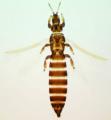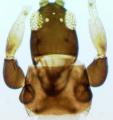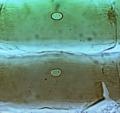Limothrips cerealium
Recognition data
Distinguishing features
Female fully winged. Body brown, tarsi and antennal segment III yellowish; fore wings light brown. Head longer than wide, projecting in front of eyes; three pairs of ocellar setae present, pair III anterolateral to triangle, scarcely longer than distance between two ocelli. Antennae 8-segmented; segment III asymmetric with simple sensorium at apex, IV with sensorium simple. Pronotum with one pair of long posteroangular setae. Metanotum reticulate, campaniform sensilla present, median setae arise behind anterior margin. Fore wing first vein with 2 setae on distal half, second vein with about 8 setae. Abdominal tergites reticulate medially, with one pair of campaniform sensilla close to posterior margin; craspedum not developed; tergite X with one pair of stout thorn-like setae at posterior. Sternites II–VII with 5–10 discal setae, without craspeda.
Male wingless, without ocelli on head; tergite IX medially with pair of stout thorn-like setae on tubercles, posterolateral pair of setae also short and stout; sternites III–VII with small sub-circular pore plate.
Related and similar species
The genus Limothrips includes six species that are considered to be valid (zur Strassen, 2003). These all live on various grasses. Although they came originally from Europe, three species are now widespread around the world.
Taxonomic data
Current valid name
Limothrips cerealium Haliday
Original name and synonyms
- Thrips (Limothrips) cerealium Haliday, 1936: 445
- Limothrips avenae Hinds, 1902: 139
- Limothrips aptera Karny, 1914: 56
- Limothrips minor Bagnall, 1927: 565
- Limothrips astutus Priesner, 1964: 115
Family placement
Thripidae, Thripinae
Common names
Thunder fly
Biological data
Life history
Breeding on leaves and in leaf axils.
Host plants
Various Poaceae, including cereal crops.
Tospoviruses vectored
None
Crop damage
Causing dead tips in various grasses and young cereal crops (Lewis, 1997).
Distribution data
Area of origin
Western Europe
Distribution
Worldwide in temperate areas, but although recorded from Puerto Rico it is not usually found in the wet tropics.










